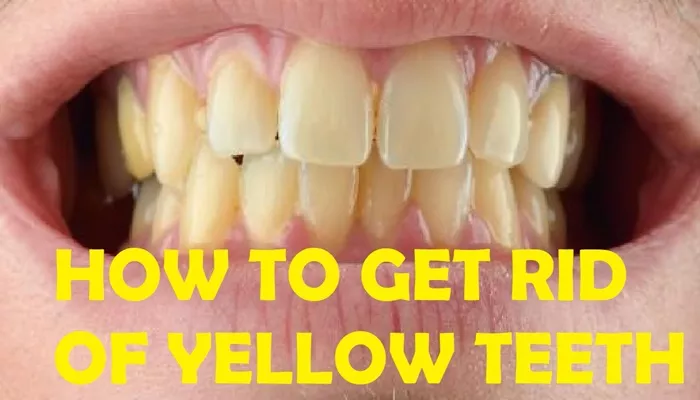Yellow stains between teeth are a common concern for many individuals seeking a brighter, healthier smile. These stains can be caused by various factors, including poor oral hygiene, dietary choices, smoking, and certain medical conditions.
Removing yellow stains from between teeth can be challenging, but with the right approach, it is possible to restore the natural whiteness of your teeth. This article will explore effective methods and preventive measures to help you achieve and maintain a stain-free smile.
Causes of Yellow Stains Between Teeth
1. Poor Oral Hygiene
Inadequate brushing and flossing can lead to plaque buildup, which eventually hardens into tartar. Tartar, also known as calculus, can appear yellow and is often found between teeth. Regular dental check-ups and professional cleanings are essential to prevent tartar formation.
2. Dietary Choices
Certain foods and beverages are notorious for causing stains on teeth. Coffee, tea, red wine, and dark-colored fruits and vegetables can contribute to yellowing between teeth. Acidic foods and drinks can also erode enamel, making teeth more susceptible to staining.
3. Smoking and Tobacco Use
The nicotine and tar in tobacco products can cause stubborn yellow stains on teeth. Smokers often struggle with discolored teeth, which can be particularly noticeable between teeth where it is harder to clean effectively.
4. Medical Conditions and Medications
Certain medical conditions, such as dry mouth (xerostomia) and gastroesophageal reflux disease (GERD), can contribute to tooth discoloration. Additionally, some medications, including antihistamines, antipsychotics, and high blood pressure medications, can cause yellowing of the teeth as a side effect.
Effective Methods to Remove Yellow Stains Between Teeth
1. Regular Brushing and Flossing
Brushing Techniques:
Use a soft-bristled toothbrush and fluoride toothpaste.
Brush at least twice a day, ensuring you reach all areas of your mouth, including the spaces between teeth.
Consider using an electric toothbrush for more effective cleaning.
Flossing:
Floss daily to remove plaque and food particles from between teeth.
Use dental floss or interdental brushes to clean the tight spaces between your teeth.
see also: Is Hismile Teeth Whitening Safe?
2. Professional Dental Cleanings
Regular Dental Visits:
Schedule biannual visits to your dentist for professional cleanings.
Dental hygienists use specialized tools to remove tartar and stains that cannot be eliminated with regular brushing and flossing.
For severe cases of tartar buildup, your dentist may recommend scaling and root planing, a deep cleaning procedure that removes tartar from above and below the gumline.
3. Whitening Toothpaste and Mouthwash
Whitening Toothpaste:
Choose a whitening toothpaste that contains mild abrasives and chemical agents designed to remove surface stains.
Be cautious with abrasive toothpaste, as excessive use can wear down enamel.
Whitening Mouthwash:
Use a whitening mouthwash that contains hydrogen peroxide or other whitening agents.
Rinse your mouth daily to help remove surface stains and prevent new ones from forming.
4. Home Whitening Kits
Over-the-Counter Kits:
Purchase whitening strips, gels, or trays from your local pharmacy.
Follow the instructions carefully to avoid damaging your teeth and gums.
Custom Trays from Your Dentist:
Your dentist can provide custom-fitted trays and professional-grade whitening gel.
These trays offer a more personalized and effective whitening experience compared to over-the-counter options.
5. Natural Remedies
Baking Soda and Hydrogen Peroxide:
Create a paste using baking soda and hydrogen peroxide.
Apply the paste to your teeth and let it sit for a few minutes before brushing thoroughly.
Be mindful of using this remedy sparingly, as excessive use can damage enamel.
Apple Cider Vinegar:
Dilute apple cider vinegar with water and use it as a mouthwash.
Rinse your mouth with this solution to help remove surface stains.
Oil Pulling:
Swish a tablespoon of coconut oil or sesame oil in your mouth for 15-20 minutes.
Spit out the oil and rinse your mouth with water before brushing.
6. Professional Teeth Whitening
In-Office Whitening:
Your dentist can perform a professional whitening treatment using stronger bleaching agents.
In-office treatments often yield faster and more noticeable results.
Take-Home Whitening Kits:
Your dentist can provide take-home whitening kits with custom trays and professional-grade gel.
These kits offer the convenience of whitening at home with the guidance of your dentist.
7. Veneers and Bonding
Veneers:
Porcelain veneers are thin shells that cover the front surface of your teeth, masking discoloration and other imperfections.
Veneers are a long-term solution for severe staining that cannot be addressed with whitening treatments.
Bonding:
Dental bonding involves applying a tooth-colored resin to the stained areas.
The resin is shaped and polished to blend with your natural teeth, effectively covering stains.
Preventive Measures to Avoid Yellow Stains
1. Maintain Good Oral Hygiene
Brush and Floss Regularly:
Brush your teeth at least twice a day and floss daily to prevent plaque buildup and staining.
Use a Mouthwash:
Incorporate an antimicrobial mouthwash into your oral hygiene routine to reduce plaque and bacteria.
2. Watch Your Diet
Limit Staining Foods and Drinks:
Reduce your consumption of coffee, tea, red wine, and dark-colored fruits and vegetables.
Drink water after consuming these items to help rinse away potential stains.
Avoid Acidic Foods and Drinks:
Minimize your intake of acidic foods and beverages that can erode enamel and make teeth more prone to staining.
3. Quit Smoking
Tobacco Cessation:
Seek support to quit smoking or using other tobacco products.
Your dentist or doctor can provide resources and advice to help you quit.
Conclusion
Yellow stains between teeth can be unsightly and affect your confidence. However, with proper oral hygiene, regular dental visits, and effective whitening methods, you can achieve a brighter, healthier smile. Remember to maintain a consistent oral care routine and make mindful dietary choices to prevent future staining. If you struggle with persistent stains, consult your dentist for professional advice and treatment options tailored to your needs.

